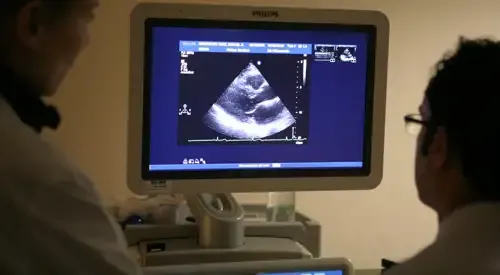Valve diseases
"Medical treatment includes primarily the prevention of bacterial endocarditis and the treatment of heart failure".
DR. RAFAEL RUIZ SALMERÓN
SPECIALIST. CARDIOLOGY DEPARTMENT

Valve diseases are alterations in the valve structure. They have different origins and cause abnormal function of the heart as a pump.
In young people, the valve most frequently affected is the mitral valve, while in older people, it is the aortic valve.
The fundamental manifestation is heart failure, respiratory distress, fatigue and leg swelling.
In its initial stages, treatment can be medical to try to improve and prevent heart failure.
In more advanced stages and depending on the degree of impact of the disease, interventionist treatment through valve dilation or surgery may be indicated.

What are the symptoms of a valve disease?
The fundamental manifestation of the valvular diseases is the cardiac insufficiency, with appearance of respiratory difficulty, tiredness and swelling of the legs, mainly in the zone of the ankles.
Breathing difficulty may also occur, more or less suddenly, when lying down, improving when standing up and forcing the patient to remain seated.
On other occasions, palpitations, loss of consciousness or syncope may occur, as well as pain or a feeling of tightness in the chest.
Do you have any of these symptoms?
You may have heart valve disease
What are the causes of valve diseases?
- Currently, the most frequent cause of valve diseases is degenerative, age-related and different types of degenerative alteration of valve tissue.
- Until a few years ago, the most frequent cause was rheumatic fever. This is a disease of an immune nature related to a streptococcal infection.
- Infectious origin, as a consequence of infectious endocarditis.
- Sometimes, when there is a lack of irrigation of the heart muscle (coronary disease), the valve function can be altered, mainly of the mitral valve.
- There is the possibility of congenital valve malformation (from birth), especially of the aortic valve.
What is your prognosis for valve disease?
Generally, the prognosis of valve diseases is favorable with treatment, so it is very important to choose the time of surgical and interventional treatment that radically change the natural evolution of the disease.
The decision to intervene is made before irreversible sequelae occur on the heart itself, such as the exaggerated dilation of the cardiac chambers, especially the left ventricle, which can lead to the appearance of chronic heart failure despite surgical treatment.
How is valve disease diagnosed?

Generally, the doctor detects the appearance of a murmur when he or she listens to the patient. This murmur is the noise produced by the turbulence and vibration of the blood, which appear as a consequence of the valve injury.
The murmur is usually different depending on the type of injury (narrowing or regurgitation) and the affected valve (mitral, aortic, tricuspid or pulmonary).
The electrocardiogram and chest x-ray allow us to appreciate the consequences of the valve disease.
But the fundamental exploration for its diagnosis is the echocardiography with doppler study. This technique allows to study in a very precise way the type and degree of injury of the valvular affectation, being essential for its study.
If coronary artery disease is suspected, it may be necessary to perform a multislice CT scan or coronariography.
How are valve diseases treated?
In the early stages of valve diseases. Their goal will be to improve and prevent heart failure.
On occasion, antiarrhythmics and/or anticoagulants may be required.
In more advanced stages and, depending on the degree of impact of the disease, surgical treatment is necessary.
This is an interventionist treatment through valve dilation or a surgical intervention.
The Department of Cardiac Surgery of the Clinic has an experience of more than 6,000 valvular interventions.
The surgery of these lesions can consist of:
- Repair of the valvular lesion, which is not always possible.
- Substitution of an artificial prosthetic valve, which occurs in most cases.
These artificial valves can be:
- Biological: derived from animal tissues such as pigs or bovine pericardium. Their main advantage is their great biocompatibility and that, in some cases, they do not need oral anticoagulants. Its disadvantage is that, being animal tissues, they are damaged over time (between 15 and 20 years). They are used more in people whose age exceeds 65 years.
- Mechanical: manufactured with very resistant materials such as pyrolite carbon and titanium. They are much more durable than biological ones (in test beds up to 400 years), but they are not as biocompatible, so it is necessary to take anticoagulants for life to avoid the formation of thrombi.
- Homografts: they are biological and come from human donors. The availability of this type of graft is much more limited and, for this reason, they are used in special situations.
Currently, most mitral valve operations at the Clinic are performed using a less invasive technique (through smaller incisions) called Port Access®.
Thanks to this technique, we achieve a faster recovery in the postoperative period, better aesthetic results and a reduction in hospital stays. In this way, the patient remains hospitalized from 5 to 7 days, depending on each patient and their situation prior to the intervention.
Where do we treat it?
IN NAVARRE AND MADRID
The Department of Cardiology
of the Clínica Universidad de Navarra
The Department of Cardiology of the Clinica Universidad de Navarra is a center of reference in different diagnostic techniques and coronary treatments.
We have been the first center in Europe to place a pacemaker by means of a catheterization without the need to open the chest, for cases of severe heart failure.
The Cardiology Department of the Clinic collaborates with the Radiology and Cardiac Surgery Departments to achieve a quick and precise diagnosis of the patient.

Why at the Clinica?
- Specialized Arrhythmia Unit of national reference.
- Unit of Hemodynamics and Interventionist Cardiology equipped with the best technology.
- Cardiac Imaging Unit to achieve the highest diagnostic accuracy.


















